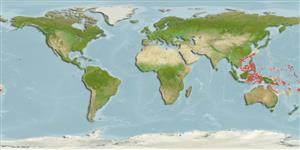Klassifizierung / Names
Namen | Synonyme | Catalog of Fishes(Gattung, Arten) | ITIS | CoL | WoRMS | Cloffa
>
Mulliformes (Goatfishes) >
Mullidae (Goatfishes)
Etymology: Upeneus: Greek, ypene, -es = upper lip (Ref. 45335); stenopsis: Name from the Greek word stenos, meaning 'narrow'; referring to the rather narrow (both in depth and width) caudal peduncle of the new species..
Environment: milieu / climate zone / depth range / distribution range
Ökologie
seewasser demersal; tiefenbereich 165 - 275 m (Ref. 92287). Tropical
Pacific Ocean: North to North-East Australia; Quezon, Philippines. The first record of a deep-water Upeneus goatfish for the Pacific.
Size / Gewicht / Alter
Maturity: Lm ? range ? - ? cm
Max length : 13.1 cm SL Männchen/unbestimmt; (Ref. 92287)
Kurzbeschreibung
Morphologie | Morphometrie
Rückenflossenstacheln (insgesamt): 8; Rückenflossenweichstrahlen (insgesamt): 9. This species is characterized by the following: Dorsal fins VIII + 9; pectoral fins 15-16; gill rakers 7-8+18-20 = 25-28; body depth at first dorsal-fin origin 22-25% SL; body depth at anus 18-21% SL; caudal-peduncle depth 7.4-7.8% SL; maximum head depth 22-23% SL; head depth through eye 18-19% SL; head length 33-34% SL; orbit length 9.2-9.9% SL; upper jaw length 14-15% SL; barbel length 21-22% SL; caudal-fin length 26-28% SL; anal-fin height 15-16% SL; pelvic-fin length 18-19% SL; pectoral-fin length 23-25% SL; first dorsal-fin height 20-23% SL; second dorsal-fin height 14-16% SL; total number of oblique caudal-fin bars 7-9, colour of bars changing from pale brown proximally to dark brown towards rear caudal-fin margin; dark bars on upper caudal-fin lobe 4-5 (including one bar close to rear end of lateral line), slightly increasing in width distally; lower caudal-fin lobe with 3-4 bars, of similar width as white interspaces between bars; first dorsal-fin tip black; caudal-fin bars and black dorsal-fin tip retained on preserved fish; barbels white; lateral body stripes absent; head and body silvery laterally and reddish dorsally, belly and ventral side of peduncle white; preserved fish dorsally or entirely pale brown or brown, with ventral part of body and head covered by white or silvery pigment (Ref. 92287).
Life cycle and mating behavior
Geschlechtsreife | Fortpflanzung | Ablaichen | Eier | Fecundity | Larven
Uiblein, F. and M. McGrouther, 2012. A new deep-water goatfish of the genus Upeneus (Mullidae) from northern Australia and the Philippines, with a taxonomic account of U. subvittatus and remarks on U. mascareinsis. Zootaxa 3550:61-70. (Ref. 92287)
IUCN Rote Liste Status (Ref. 130435)
Bedrohung für Menschen
Harmless
Nutzung durch Menschen
Mehr Information
NamenSynonymeMetabolismusRäuberÖkotoxikologieFortpflanzungGeschlechtsreifeAblaichenSpawning aggregationFecundityEierEientwicklung
Alter/GrößeWachstumLänge-GewichtLänge-LängeLängenhäufigkeitenMorphometrieMorphologieLarvenLarven Pop.Dyn.RekrutierungDichteBRUVS
ReferenzenAquakulturAquakultur ProfilZuchtlinienGenetikElectrophoresesVererbbarkeitKrankheitenVerarbeitungNutrientsMass conversion
PartnerBilderStamps, Coins Misc.LauteCiguateraGeschwindigkeitSchwimmstilKiemenoberflächeOtolithsGehirngrößeSehfähigkeit
Tools
Zusatzinformationen
Download XML
Internet Quellen
Estimates based on models
Preferred temperature (Ref.
123201): 14.2 - 21.4, mean 15.3 °C (based on 33 cells).
Phylogenetic diversity index (Ref.
82804): PD
50 = 0.5000 [Uniqueness, from 0.5 = low to 2.0 = high].
Bayesian length-weight: a=0.00955 (0.00454 - 0.02011), b=3.10 (2.93 - 3.27), in cm total length, based on LWR estimates for this Genus-body shape (Ref.
93245).
Trophic level (Ref.
69278): 3.5 ±0.4 se; based on size and trophs of closest relatives
Widerstandsfähigkeit (Ref.
120179): hoch, Verdopplung der Population dauert weniger als 15 Monate. (Preliminary K or Fecundity.).
Fishing Vulnerability (Ref.
59153): Low vulnerability (10 of 100).
